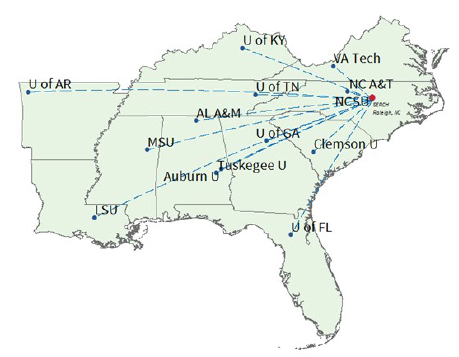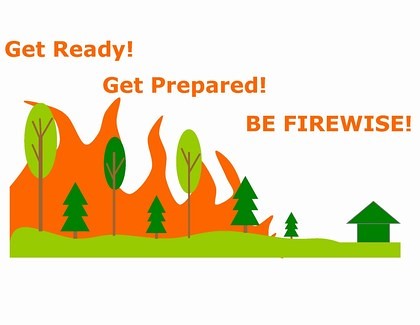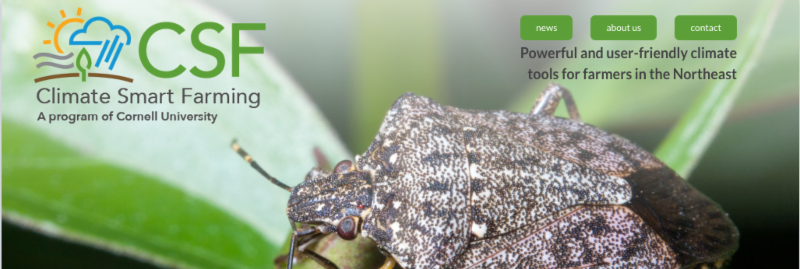The first meeting of the Southeast Hub’s Network of Partners was convened in July. Members include representatives from all of the region’s Land-Grant Universities and non-profit organizations. The group discussed how to best translate research findings to outcomes on the ground and work together to address critical needs of southeastern land managers. If you are interested in becoming a SERCH partner contact Steve McNulty at smcnulty@fs.fed.us.
Author: Site Owner
2016 Champion Trees Announced
 This year’s champions have been crowned! The 2016 Champion Trees National Register is full of more than 750 giants that are the biggest known trees of their species. This year, big tree hunters from across the country scoured backcountry wilderness, rural farmland, city centers and even college campuses to find 64 new champions to add to the register.
This year’s champions have been crowned! The 2016 Champion Trees National Register is full of more than 750 giants that are the biggest known trees of their species. This year, big tree hunters from across the country scoured backcountry wilderness, rural farmland, city centers and even college campuses to find 64 new champions to add to the register.
Big tree hunters in Oregon discovered the most new champions at 14, while Texas and Montana each contributed nine new giants to the register. Seven massive oaks and six impressive pines were entered into the competition, including a Coast live oak with a 110-foot crown and a sugar pine that reaches 241 feet into the sky. But, the real star of the 2016 champions was a Coast Douglas-fir from Oregon, which stole the crown of 10th largest tree in the register! Much of its 792 overall points came from its astonishing 444-inch trunk circumference.
Big trees like these have been compiled in the National Register since 1940 as a way of celebrating the protection of ancient forests and inspiring the restoration of the giants of tomorrow. Old, large trees are a critical component of a healthy forest ecosystem and are the preferred habitat of many threatened and endangered wildlife species.
Without further ado, view all the champions in the 2016 Champion Trees National Register!
Also, a special thanks to The Davey Tree Expert Company, the premier sponsor of our Big Tree Program!
The post 2016 Champion Trees Announced appeared first on American Forests.
Be a Fire Wise know it all

Get Ready, Be Prepared, Be Firewise
You’ve heard this from us during previous fire seasons, and you’ll continue to hear it from us every fire season: You can never be Fire Wise enough. And, with this being National Preparedness Month, you’re going to hear it a lot.
The theme this year for National Preparedness Month is “Don’t Wait, Communicate. Make your Emergency Plan Today”. This straight forward theme makes it very clear that planning is crucial to protect yourself, your loved ones and your property against wildfire.
The U.S. Forest Service wants us all to hear and understand this message because, simply, it saves lives and property and makes the job of the heroic firefighting crews a lot safer for them so they can come home to their families.
So what is being Fire Wise and what do you need to know?
One of the first steps is learning where you live. What do we mean by this? It’s understanding what type of landscaping you have around your property. For instance, are those pines just a little too close to your house? Should you really have a wood shingled roof in the fire-prone area where you live?
Another step in beefing up your Fire Wise knowledge skills is connecting with neighbors and sharing what you’ve learned and learning what they know. You might be surprised what fire prevention tips can make all the difference in protecting your home and neighborhood.
And, this year, National Preparedness Month focuses on training youth and helping the elderly in understanding what they can do to be fire wise as well.
So often when TV film crews scan a devastated neighborhood after a sudden wildfire overtook it, we see the image of one or two homes that survived. From what I’ve learned about being Fire Wise, I can pretty much guess that those homeowners had prepared for the very day that this might happen by being Fire Wise.
Cornell Climate Tools for the Northeastern US

PNW Researchers and CLN Webinar Guests Expand Impact on AgClimate.net
 John Abatzoglou and Sanford Eigenbrode have both contributed to the CLN Webinar Series. They have taken the information they shared here and expanded it to AgClimate.net providing web resources for the topics they discussed for the Climate Learning Network. The posts include links to the downscale climate data tools discussed by John and in depth descriptions of the pests Sanford presented. Please make sure to check out the posts if you attended the webinars and are looking for more information on these topics!
John Abatzoglou and Sanford Eigenbrode have both contributed to the CLN Webinar Series. They have taken the information they shared here and expanded it to AgClimate.net providing web resources for the topics they discussed for the Climate Learning Network. The posts include links to the downscale climate data tools discussed by John and in depth descriptions of the pests Sanford presented. Please make sure to check out the posts if you attended the webinars and are looking for more information on these topics!
Test Post
Testing featured image 2
The post Test Post appeared first on American Forests.
What is new in European climate research?
What did I learn from the 2016 annual European Meteorological Society (EMS) conference that last week was hosted in Trieste (Italy)?
I think the biggest news from the conference was that new reanalyses are soon to be released by the European Centre for Medium-ranged Weather Forecasts (ECMWF). One new product known as ERA-5 will replace the older called ERAINT, and preliminary results suggest a significant improvement in addition to higher spatial resolution. Check this webportal for ECMWF’s different reanalysis products. By the way, the naming convention of these reanalyses is rather strange and seems to defy any logic (first there was ERA-15, then ERA-40, followed be ERAINT, ERA-20C,…).
A coupled reanalyses known as CERA-20 was also presented, which breaks with the traditional atmosphere-only products. A coupled assimilation scheme for both atmosphere and ocean seems to give better quality and more consistent results.
Some of the results presented at the conference involved trends in temperature and precipitation statistics, and we are now seeing more intense rainfall. This is not entirely new, but we are getting a clearer picture on intense hourly rainfall. Also, observations suggest more drought in eastern Mediterranean, which is a region affected by both subtropical and mid-latitudinal weather phenomena.
If I were to pick one out of several good candidates, then perhaps the most interesting talk in the synoptic climatology session (for which I was co-convener) was on the ocean’s heat loss to atmosphere connected with surface turbulence. The message was that most of the heat exchange takes place over short time intervals, and that the most extreme magnitudes of heat exchange seem to be associated with high pressure system with cold air outbreak and an interaction with cyclones.
One tradition of the ESM conferences is to award the silver medal, and this year’s EMS Silver medal was given to Michel Jarraud, who, according to my notes, said that he regards meteorology as the leading edge in science and that numerical weather prediction is one of the great success stories. He also observed that weather was significant in the propagation of ebola, and that there is an urgency to act on climate change mitigation and adaptation. Another message was that we should not try to be perfect – it’s too costly and inefficient. Much of our knowledge is good enough for action on climate change. Another concern was about capacity building and that some nations soon may have meteorological services which will run without meteorologists.
Another impression was that climate adaptation seems to be stuck (also see recent post on mid-latitude storms) with limited resources devoted to climate services and little demand for climate information for decision making. There is still a question of added value for people who make the effort to incorporate such information in their business model or in governance (also see the post on added-value).
The conference had several parallel sessions and that spanned over a wide range of themes on applied meteorology and climatology, such as communication, TV meteorology, and forecasting, in addition to common climate research issues (check the conference website). I could not cover all, so I may have missed some of the interesting results.
Zelkova serrata
<!– Tree Circumference:
Height:
Crown Spread:
Total Points:
Location:,
Publically Accessable:
Nominated By:
Year Nominated:
–>
Found a bigger tree? Nominate it here.
The post Zelkova serrata appeared first on American Forests.
Prunus armeniaca
<!– Tree Circumference:
Height:
Crown Spread:
Total Points:
Location:,
Publically Accessable:
Nominated By:
Year Nominated:
–>
Found a bigger tree? Nominate it here.
The post Prunus armeniaca appeared first on American Forests.
Oemleria cerasiformis
<!– Tree Circumference:
Height:
Crown Spread:
Total Points:
Location:,
Publically Accessable:
Nominated By:
Year Nominated:
–>
Found a bigger tree? Nominate it here.
The post Oemleria cerasiformis appeared first on American Forests.




